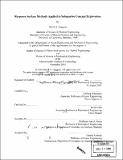Response surface methods applied to submarine concept exploration
Author(s)
Goggins, David A. (David Alexis), 1966-
DownloadFull printable version (10.02Mb)
Other Contributors
Massachusetts Institute of Technology. Dept. of Mechanical Engineering.
Advisor
Clifford Whitcomb.
Terms of use
Metadata
Show full item recordAbstract
It is estimated that 70 to 85 percent of a naval ship's life-cycle cost is determined during the concept exploration phase which places an importance in the methodology used by the designer to select the concept design. But trade-off studies are guided primarily by past experience, rules-of-thumb, and designer preference. This approach is ad hoc, not efficient and may not lead to an optimum concept design. Even worse, once the designer has a "good" concept design, he has no process or methodology to determine whether a better concept design is possible or not. A methodology is required to search the design space for an optimal solution based on the specified preferences from the customer. But the difficultly is the design space, which is non-linear, discontinuous, and bounded by a variety of constraints, goals, and thresholds. Then the design process itself is difficult to optimize because of the coupling among decomposed engineering disciplines and sub-system interactions. These attributes prevent application of mature optimization techniques including Lagrange multipliers, steepest ascent methods, linear programming, non-linear programming, and dynamic programming. To further improve submarine concept exploration, this thesis examines a statistical technique called Response Surface Methods (RSM). The purpose of RSM is to lead to an understanding of the relationship between the input (factors) and output (response) variables, often to further the optimization of the underlying process. The RSM approach allows the designers to find a local optimal and examine how the design factors affect the response in the region around the generated optimal point. RSM can be applied to submarine concept exploration and provide a methodology to: determine the optimal concept design based on customer preference, efficiently perform trade-off studies, determine the feasible design space, and the ability to determine in advance if a specified concept design is feasible and meets all the customer thresholds and constraints.
Description
Thesis (S.M.)--Massachusetts Institute of Technology, Dept. of Ocean Engineering; and, (S.M.)--Massachusetts Institute of Technology, Dept. of Mechanical Engineering, 2001. Includes bibliographical references (leaf 89).
Date issued
2001Department
Massachusetts Institute of Technology. Department of Mechanical Engineering; Massachusetts Institute of Technology. Department of Ocean EngineeringPublisher
Massachusetts Institute of Technology
Keywords
Ocean Engineering., Mechanical Engineering.